The Corporate Manslaughter and Corporate Homicide Act applies to organisations which cause a person’s death or exhibit a gross breach of a relevant duty of care owed to the deceased.
In this three part series, we will break down the law and how it applies to you, highlighting key issues and explaining the consequences. As always, this is for information only and does not constitute legal advice. We are always happy to give personal and detailed advice, just give us a call on 01224 900025.
So first of all, there needs to be a death.
You may find it strange mentioning this, but in the course of seminars I have delivered on this topic, I have had people ask the question “what happens if there is an accident but no one dies?”
The next thing to clarify is: what organisations are covered? The act sets out those organisations affected and that is pretty much all of them – including partnerships, trade unions/ employer’s association as long as they are an employer, and government departments (set out in Schedule 1 of the Act). Further Crown immunity for the offence no longer exists.
There are several main elements of the offence.
Relevant Duty of Care
The civil law of negligence forms the basis for the duty of care – the Act does not create new duties. The definition of the relevant duty of care can be found in section 2 of the Act. It simply lists certain existing duties of care which are now to be regarded as ‘relevant’ to this offence. They include, but are not restricted to:
Employer or Occupier duties;
Duties connected to supplying goods, systems of work and services;
Duties connected to commercial activities;
Duties connected to construction and maintenance work;
Duties connected to using or keeping plant or vehicles; and/or
Duties connected to systems of work and equipment used by employees.
Gross Breach
s.1(4)(b): ‘A breach of a duty of care by an organisation is a ‘gross’ breach if the conduct alleged to amount to a breach of that duty falls far below what can reasonably be expected of the organisation in the circumstances’.
In practice, what will and will not be held to be a ‘gross’ breach will be a matter decided by the jury. They will have to take into account any health and safety breaches by the organisation as well as how serious and dangerous those failures were.
Remember the way or ways in which the activities are managed or organised have to cause a person’s death and would have to amount to a gross breach of a duty of care.
Way in which activities are managed or organised.
Investigators will look at the actions of a number of people. Management as a whole will be considered, with reference to the attitudes that exist; the decisions taken and the reasons behind decisions; leadership and what happens in practice. These will be an issue for a Jury.
Juries will consider how the fatal activity was managed or organised throughout the organisation, including any systems and processes for managing safety and how these were operated in practice. A substantial part of the failure within the organisation must have been at a senior level (meaning the people who make significant decisions about the organisation or substantial parts of it).
Organisations will be required to show not only that they have policies and procedures in place which should have prevented such an incident, but also that they have a culture which reinforces these policies and procedures. Where an organisation fails to take reasonable steps to prevent the wrong culture arising (a culture which encourages, tolerates or leads to an offence) will be viewed as an aggravating feature of the offence.
In part 2 we will look at the role of senior management and individual liability, in part 3 we will outline penalties and sentencing.




